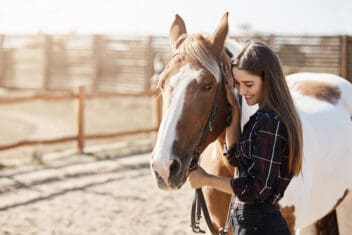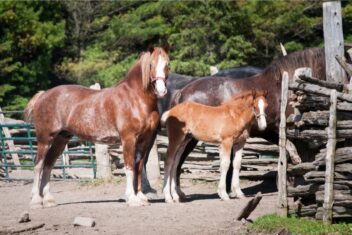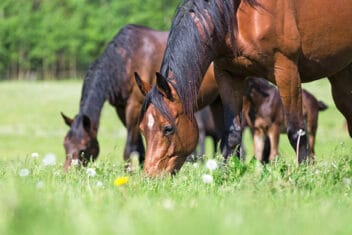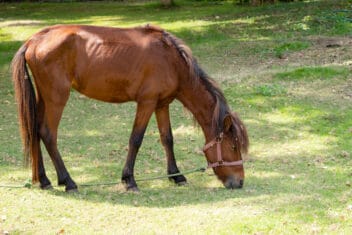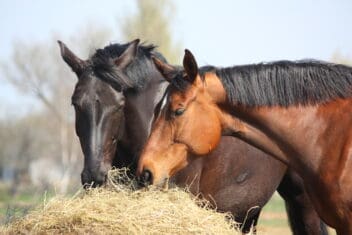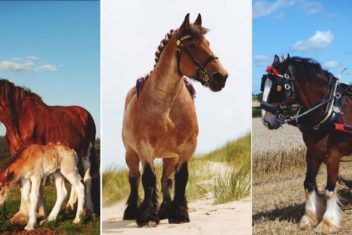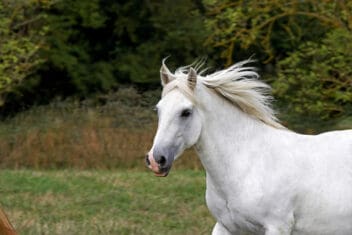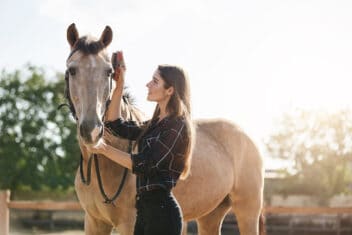Owning a horse comes with many responsibilities, including feeding them, checking on their health, and keeping them safe. Fencing horses can be challenging, especially if you have never done it before. It’s easy to be overwhelmed by all the options.
The right fence for your horse depends on your situation. You must consider the size of your property, climate, number and type of horses, and your overall budget.
To help you make the right choice, this article will tell you everything you need to know so your horse can be happy, healthy, and safe!
Before You Choose a Horse Fence
First, there are a few things you need to be aware of when it comes to deciding on which type of fencing for your horse you should pick.
Consider the visibility of the fence. Horses often run into fences if they aren’t obvious enough, which can injure your horse. Older, calm horses might not have this problem, but young or active horses are more likely to run into a thin wire fence.
If your horse breaks through the fence, it could run onto the road and be injured. You must make sure you have a visible fence for horses that are more lively and live in groups.
Height
In addition to visibility, consider the height of the fence. Ideally, all horse fences should be 4.5-5 feet tall. However, if you have large horses, you might want to increase the height to 6 feet tall.
The bottom of the fence should be 6-8 inches off the ground to avoid foals from rolling under and adult horses from grazing beyond the field.
You’ll also need several rails in between the top and the bottom. If your rails are too far apart, your horse might be able to escape.
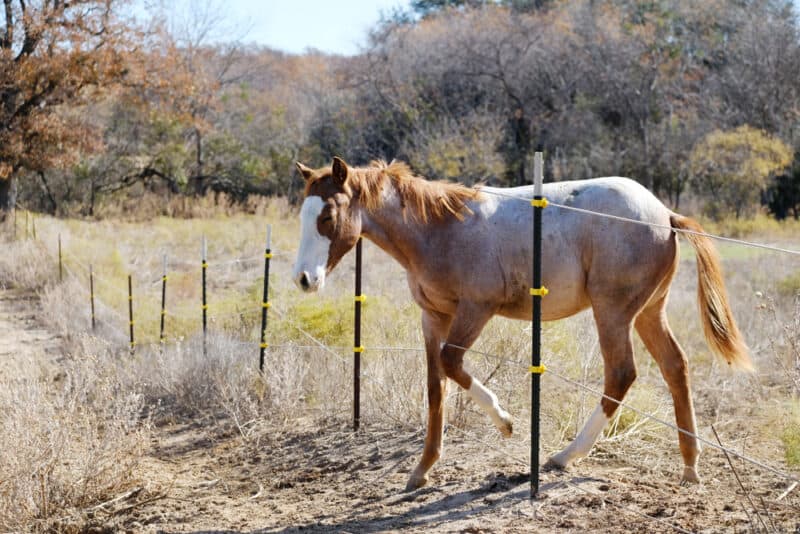
Gates
A good gate is an essential element of fencing horses. A gate makes feeding, moving machinery, and visiting your horses a lot easier. Otherwise, it’s difficult to regularly check up on your horses and impossible to remove them from the field.
When picking the location for the gate, you need to think about how wide you want it, where to place it, and how well it supports surrounding poles. Also, decide if you want one that swings open easily or has a sturdy latch to prevent escape artists from getting out.
The width can vary from just large enough for you and the horse to move through to wide enough that you can drive a truck through.
Next, decide which material works best. On the simple end of things, you can make a gate out of rope or a piece of wood. These are cheap and effective, but they can also wear out quickly and are pretty inconvenient.
Metal, plastic, and wood gates are easier to use, though they cost more. These gates can latch securely, or you can loop a chain around them to keep them closed.
Security
You need to decide what the stakes are if your horse escapes. If the other side of the fence is just more grass as far as the eye can see, you might not need to worry about installing a highly secure fence. Rope might even get the job done.
But if there is a busy road or an unfriendly neighbor next to the pasture, or if your horse is a bit of an escape artist, you need to choose something very secure.
Herd Management
Your herd will help determine what kind of fence will work for you. An active, constantly changing herd needs sturdier fencing than two calm, older mares that get along well.
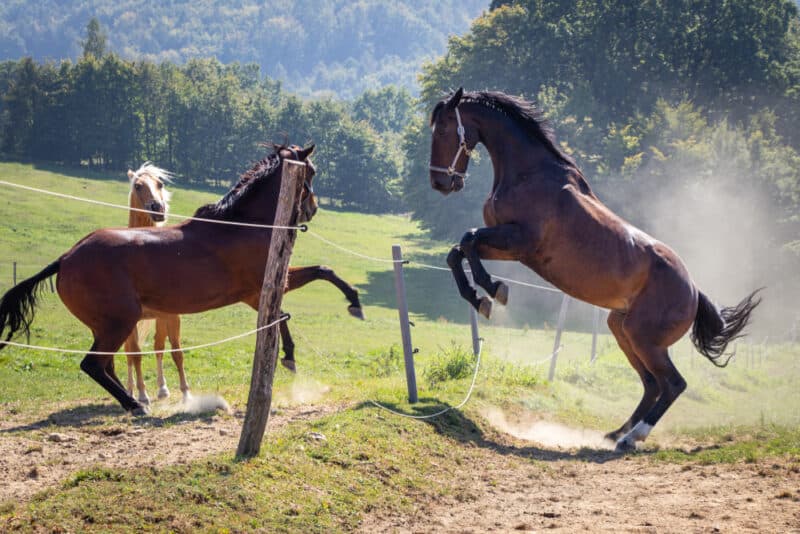
If you intend to keep horses separated from each other by a fence, it should be highly visible and very sturdy. Otherwise, you’ll likely find yourself dealing with injuries or escape.
Predator Threat
Your fence keeps your horses in, but it can also keep predators out. If you have frequent visits from coyotes, domestic dogs, bears, or even wolves, a solid fence can help deter them.
Types of Horse Fences
Choosing the perfect horse fencing can be overwhelming, given the endless options available. To narrow it down, you need to consider the various aspects of the different types of horse fences to find the right one.
Regardless of which material you choose, never use t-posts to secure it to the ground. T-posts work well for cattle or other slow-moving animals, but horses are too active and can easily get impaled on them.
Electric
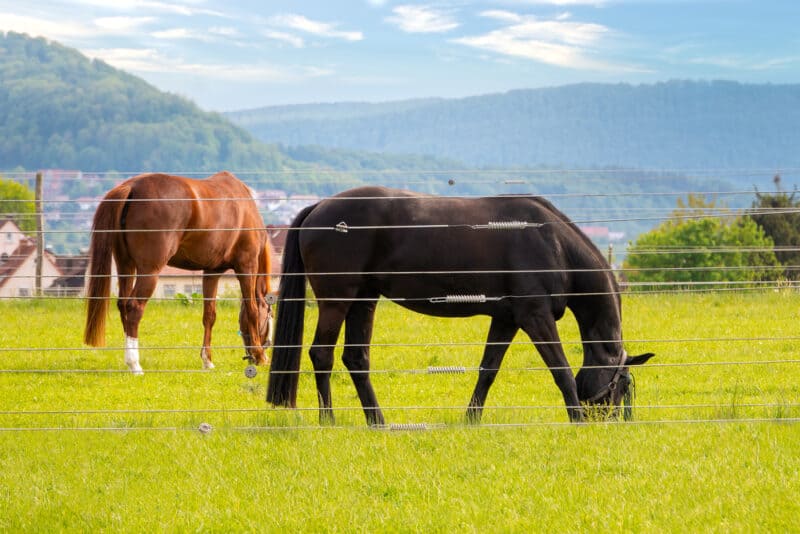
One of the most popular options is electric fencing because it’s affordable and effective.
On top of being cheap, it’s easy to install, and just a thin wire is enough to keep your horse from getting out. If you’re worried about zapping your hoofed friend, don’t panic. The electric fence only gives off a slight jolt when the horse touches it. It’s more of a warning.
The danger with electric fencing by itself is that if a horse rears up or runs into the wire, it can get cut or caught up in it.
Bad weather conditions and electrical shortages can render an electric fence ineffective. If you are looking for an electric fence and are in a rural area where power shortages can occur frequently, that’s something to bear in mind.
There are excellent solar options available if the grid is unreliable in your area.
Wood
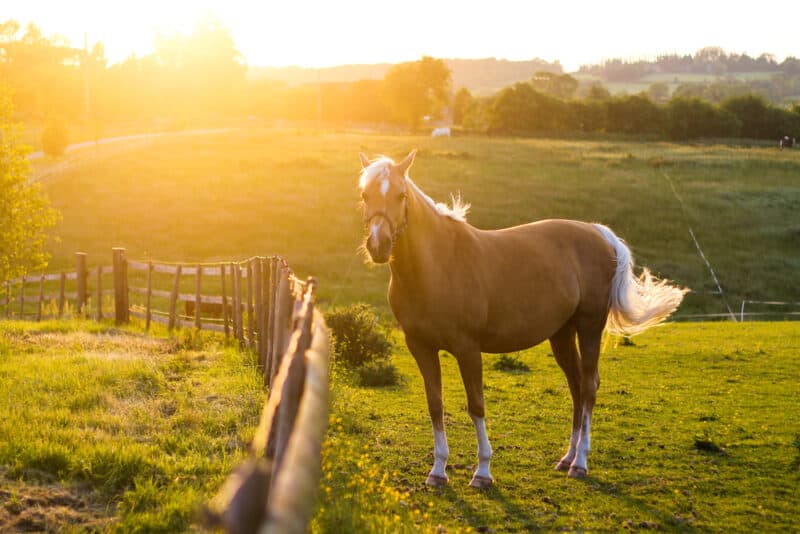
Wood is a sturdy, attractive option for fencing for your horse. They’re typically built with wood planks that are painted, stained, or sealed. You often see this type of fence at facilities that house equestrian competitions.
In terms of visibility, wooden fences are ideal. They’re easy to spot and help horses stay safely within the boundary of your pasture. Another advantage of wooden fences is their durability. If you look after them, they can last decades.
Wooden fences are usually made from softwood like pine or hardwood such as redwood, cedar, and oak. The available material depends on your location and what type of wood is available. Also, think about your budget. Hardwoods are usually more expensive.
If you decide to paint your fence, you need to commit to touch-up painting every year or two.
Split rail wood fencing is another option. These take a lot more work, but you can build them using wood on your property. There are historic split rail fences across the US that have been around for over a century, so they can last a long time with maintenance.
Wire
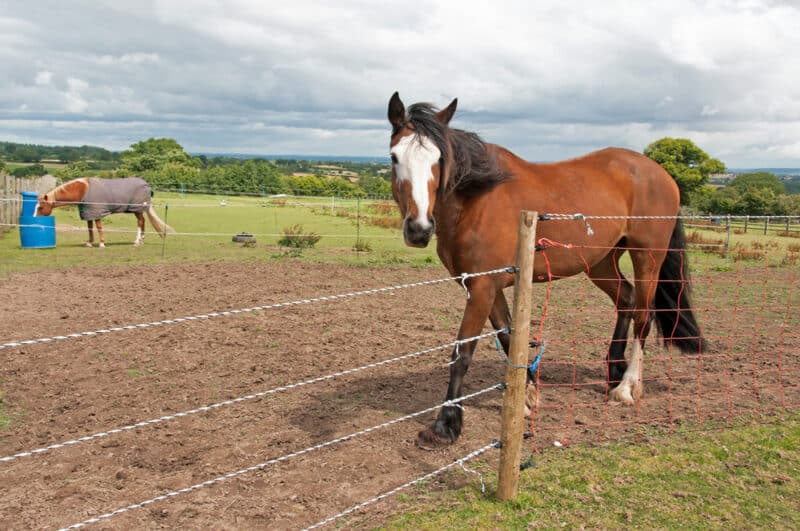
Woven wire fencing is sustainable, affordable, and doesn’t need a lot of maintenance. You can find several styles to suit your needs.
It can be challenging to install a woven wire fence, especially if you have never installed one before. You can succeed with the correct tools and education or a hired professional.
Keep in mind that this choice has less visibility than others. It also has a higher risk of cutting your horse if they rear up onto the wire and catch a leg or neck. You can get the best of both wood and wire by using wood for the top rail and wire for the lower rails. That way, your horse has less of a chance of getting caught on the wire, and there’s plenty of visibility, so they don’t try to run through it.
You need to tighten all-wire fences up regularly to maintain tension. Wire reinforced by wood requires less frequent tightening.
Mesh wire doesn’t require tightening nearly as often, if at all, and is safer for your horse because the openings are too small for noses or hooves to get caught in. They cost more than woven wire, but they tend to be more durable. Mesh wire can also keep out predators or protect smaller animals like chickens.
Smooth wire is the cheapest option. Imagine a barbed wire fence without the barbs, and that’s the idea. These aren’t very visible, and horses can get cut if they get caught on them. Coating the wire makes it more visible and safer.
Plastic

Plastic is a good option if you want something highly visible but more affordable than wood or metal.
Pick plastic that is durable against changing weather conditions and sunlight exposure. The best options are polyethylene (PE), polyvinyl chloride (PVC), and fiberglass.
The climate of your area is crucial when deciding between various fences because plastic becomes more brittle as the weather gets colder and then gets softer as it warms up. Over time, that can cause cracking and weakening of the material.
You can also find high tensile polymer fences, which look like wood rails but with the durability of plastic. You need to tighten these fences regularly to keep the right tension.
Rubber
Recycled rubber is a less common option but has several benefits. These fences are pretty visible, and the soft rubber is less likely to injure a horse. However, they start to sag, so they need tightening up pretty frequently.
Metal
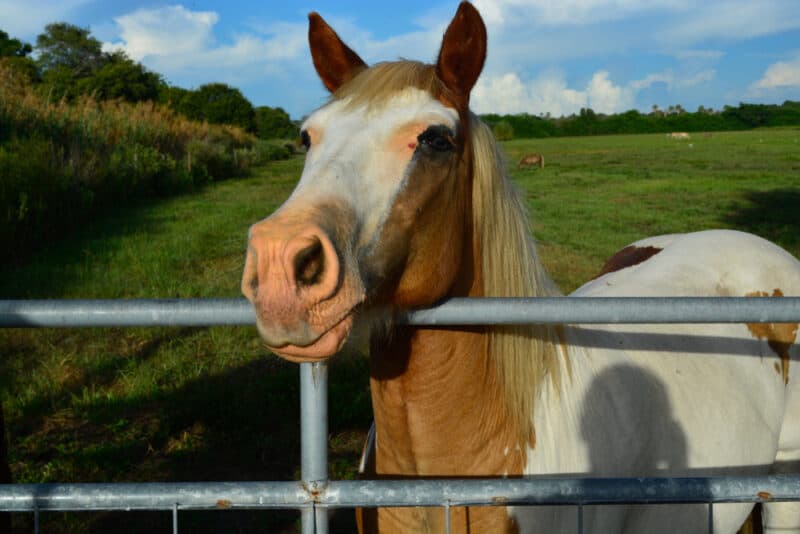
Metal fencing can range from pieces of steel fastened to wood poles all the way to elegantly designed and welded wrought iron fencing. The latter is the most expensive option you can choose, but it looks extremely nice and lasts a very long time without maintenance.
Pipe steel lasts a long time and is very solid. It’s a good option for active horses or in areas where escape could be dangerous for your horse. They’re not cheap fences, and you do need to repaint them every so often.
Combination
Many people opt to go for a combination of the above. For instance, you could create a wood frame with wood poles and a top rail and then use wire mesh to fill in below the top rails. Or you can use electric fencing for the top wire and wood rails below that.
Other Things to Consider
Determining the correct fence is not only about the material but also about the type of horse you have. For instance, two older horses will need something different from a field full of foals. A draft horse requires something different than a herd of athletic thoroughbreds.
A calm herd of older mares is safe with minimal fencing. They aren’t prone to jumping and racing around. Young, energetic horses require more durable, visible fences as they’re more active and likely to try and jump or break free.
Pasture
Of course, another element of choosing your fence is your pasture and turnout. Think about the amount of grass your horses need and if you’ll use the area as a turnout for them to run off some energy. You should utilize something more secure in a full-time pasture, while you can enclose a turnout with something a bit lighter, like wire.
The ground plays a role in what type of fence you can use. You need to sink extremely deep post holes to secure a wood rail fence, while you can string up a wire fence on more delicate posts that aren’t as deep.
If you want to divide a pasture that already has a fence around it, you can use a much less sturdy material. Rope or thin strips of plastic attached to steel posts is plenty to keep horses divided or out of areas where you don’t want them.
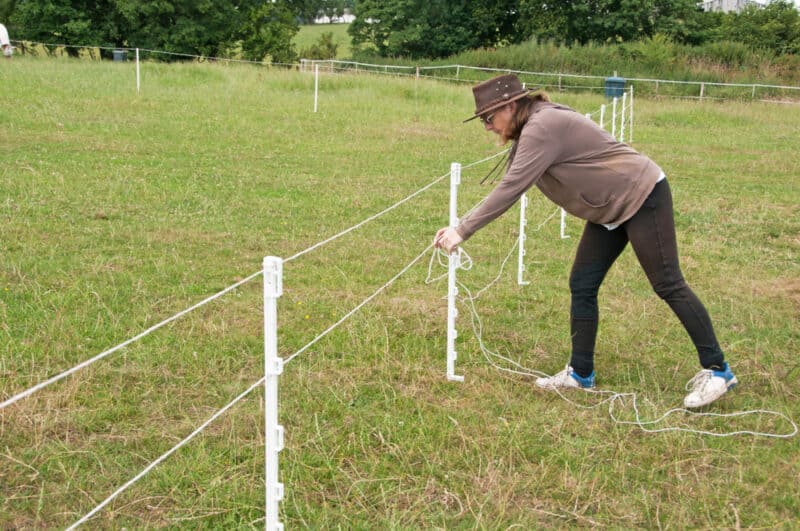
The risk is much lower if a horse breaks through or jumps these fences because they are still enclosed in a fenced area.
You should also factor in the forage on your property. If the grass is more lush and green on the other side, you can be sure that your horse will paw and chomp on the fence in an attempt to get to the good stuff.
Cost
In addition to pasture and type of horse you won, you need fencing to fit your budget. Even though a cheaper fence may be a good solution initially, these are not necessarily more affordable in the long run. You tend to get what you pay for. Maintaining a lower-budget fence can end up being pricey.
If you want something that lasts a while and that you will not need to worry about repairing all the time, then a more expensive option could be ideal. Although you need to invest the money initially, it will pay off in the long run. That said, even pricey fences require maintenance down the road.
Wood fences need painting or sealing, and metal fences need expensive repairs if they break. Wire fences tend to be less sturdy and often require re-seating or re-stringing.
Aesthetic
Do you own a horse facility for customers, such as riding lessons, for example? Or, are you a horse owner with your own plot of land?
The answer will determine whether or not you want to pick a more aesthetically pleasing fence. If you have people coming onto your property often, you might want something that looks nice, like a painted wooden fence.
If you have lots of animals and are worried about their security, you might prioritize durability over design.
Don’t Forget Maintenance
You need to be aware of maintenance costs that will come up after you have installed the fence, as that might affect how effective and useful it will be in the future. If you don’t have the time or money to repaint every few years, don’t choose wood or steel, for example.
Electric fencing will need regular replacing as parts fail or are worn out by the weather or your horse bumping, biting, or damaging them.
You should also make walking the fenceline a regular part of your routing. At least once a week, if not daily, walk along the fence and look for damage, maintenance issues, or missing parts.

